Guidelines for Selecting a 70-Inch Entertainment Center
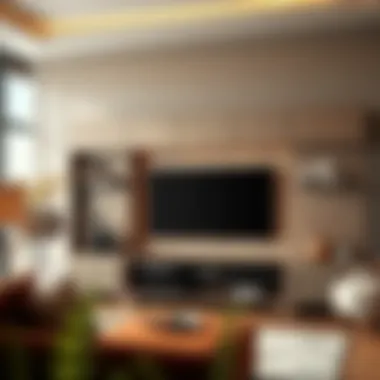
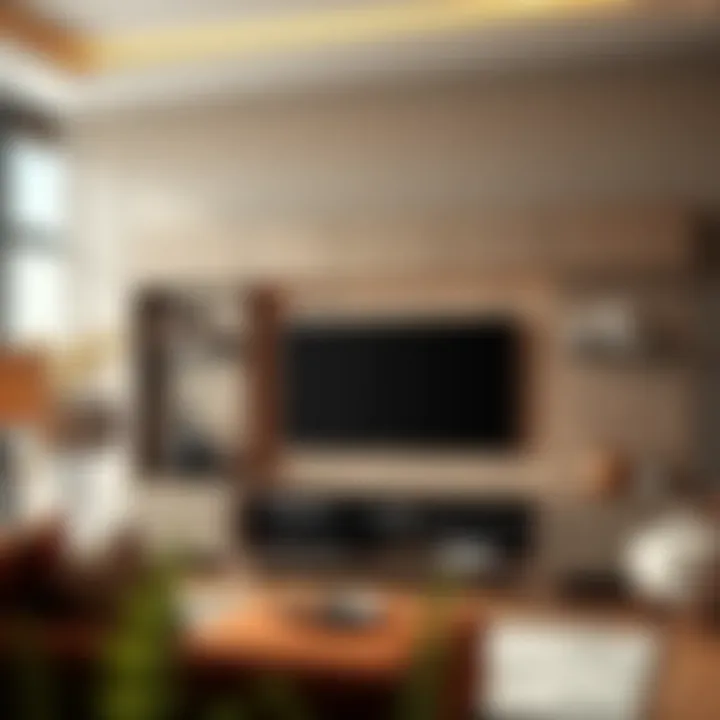
Intro
When it comes to choosing a 70-inch entertainment center, one can't simply stroll into a store and grab the first one on display. It’s akin to picking a car without even looking under the hood. There’s a world of factors involved that influence not only the aesthetic appeal but also the functional aspects of these sizable pieces of furniture. The right entertainment center does more than just hold your television; it plays a pivotal role in enhancing the entire living space.
From the current trends in furniture design to materials that will stand the test of time, understanding what’s out there is indispensable. Whether you are a homeowner looking to spruce things up or a designer aiming to create a cohesive environment, this guide aims to unravel the nuances involved in making a sound choice.
By examining popular styles, delving into the materials, and grasping the practicalities of space optimization, we can ensure that this purchase is a well-informed one—one that harmonizes style and functionality.
Furniture Trends and Styles
Current Trends in Furniture Design
In the fast-evolving world of furniture, trends come and go with the seasons, yet certain patterns find their way into the fabric of design and remain prominent. Currently, sustainability is all the rage. Many homeowners are gravitating towards eco-friendly materials and locally sourced craftsmanship. The psychological comfort that comes from nature-inspired designs cannot be understated, leading to a rise in pieces that blend colors and textures reflecting natural landscapes.
Moreover, minimalism continues to have its moment in the spotlight. Clean lines, uncluttered spaces, and multifunctionality are key features that many seek. The idea is to create a refuge from the chaos of the outside world, and a well-designed entertainment center should embody this principle as much as any coffee table or shelf. As such, simpler designs that prioritize open space tend to be more desired.
Popular Furniture Styles and Their Characteristics
Navigating the array of styles when choosing an entertainment center might feel like trying to find a needle in a haystack. Here’s a closer look at some of the styles that are stealing the show:
- Modern: Characterized by sleek surfaces, minimal ornamentation, and an emphasis on function. Ideal for those who appreciate unfussy environments.
- Rustic: Emphasizes warmth and comfort with materials like reclaimed wood and rough-hewn elements. It adds a touch of coziness that many homes crave.
- Traditional: Features intricate details and rich materials such as mahogany or cherry. This style evokes a sense of historical charm.
- Industrial: Combines wood and metal to create edgy yet chic pieces. Perfect for loft-style living spaces.
When choosing a style, consider how it complements your existing decor. The goal is not to clash with the furniture you have but to tie everything together in a way that feels coherent and well-thought-out.
"A well-chosen entertainment center is more than furniture; it’s the heart of your living area, where memories are made."
Buying and Maintenance Guides
Essential Tips for Purchasing Furniture
Before you even start shopping for a 70-inch entertainment center, it is best to take stock of your own space. Measure the area where you plan to place the center to ensure it doesn’t overwhelm the room. Consider how deep and tall you can go without sacrificing flow.
In addition, think about the technology you plan to incorporate. Smart TVs, sound systems, gaming consoles—these require thoughtful consideration about the layout and cable management. Look for features like cord management systems in the design if you prefer a clean look.
Maintenance and Care for Different Furniture Materials
Different materials require different care methods to maintain their aesthetics over time. Here’s a quick breakdown:
- Wood: Dust regularly and use a soft cloth. For shine, apply a gentle wood polish occasionally.
- Metal: Clean with mild soap and water, and dry thoroughly to prevent rust.
- Glass: Use glass cleaner and a microfiber cloth to avoid streaks.
Keeping your entertainment center in tip-top shape not only prolongs its life but also ensures it continues to enhance your home’s ambiance well into the future.
Preamble to Entertainment Centers
In today's fast-paced digital age, an entertainment center is more than just a piece of furniture; it's the heart of our leisure activities at home. For those exploring the vast variety of shelving and TV mount solutions, understanding how an entertainment center fits into a living space is crucial. It often holds our beloved televisions, gaming consoles, and sound systems, acting as a hub for all things entertainment.
When choosing a 70-inch entertainment center, we must consider its role beyond mere utility. Increasingly, these structures have transformed into key components of our living rooms, symbols of family gatherings and shared experiences. By navigating this guide, homeowners and designers will discover the intricate balance between function and style.
Evolving Perspectives on Home Entertainment
Over the last few decades, perspectives on home entertainment have shifted significantly. Once upon a time, families gathered around bulky boxes that offered limited channels and poor audio quality. Fast forward to today, the paradigm has changed entirely. With advancements in technology come expectations for seamless experiences.
Modern entertainment centers are designed to accommodate a variety of devices from streaming devices to gaming consoles. They offer ample storage for media accessories while ensuring cables are neatly tucked away.
Moreover, the size of our TVs has skyrocketed. The growing trend for larger screens leads many to opt for larger entertainment centers. A 70-inch unit not only holds large screens but also complements the scaled-up nature of modern viewing experiences. Keeping pace with trends means understanding how they directly influence our choices.
The Role of the Entertainment Center in Modern Living
The entertainment center's position in the home reflects a blend of practical and aesthetic considerations. It's not just about placing a TV on a stand; it’s about creating a focal point in the living room that radiates warmth, comfort, and connection.
An entertainment center provides an organized environment. With designated spaces for gaming, movie collections, and music devices, it helps minimize clutter and enhance visual appeal. Living rooms today strive for an inviting atmosphere where family and friends gather.
If we think about how an entertainment center fits into our lifestyle, it becomes clear its design must accommodate our habits. For example, an entertainment center that supports smart home technology integration can elevate the living experience by enabling effortless access to entertainment.
In summary, understanding the evolution of entertainment centers is key to making informed decisions. As you navigate this journey, consider how these spaces can be tailored to reflect both functionality and personal style. Using an entertainment center wisely paves the path for an enriching home entertainment experience, making every movie night or gaming session a little more special.
Why Choose a 70-Inch Entertainment Center
When deciding on the ideal entertainment center, a 70-inch model can feel like a game-changer in the realm of home aesthetics and functionality. This article aims to pin down the importance of choosing such substantial furniture, going beyond mere size to explore the various elements that make it a worthy addition. Not only does it enhance the viewing experience, but it also serves as a style statement that aligns with your overall home décor.
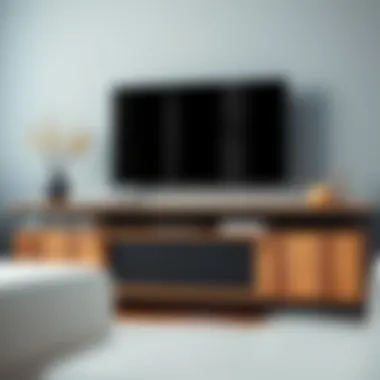

Size Considerations for Optimal Viewing Experience
The size of your entertainment center can significantly elevate your audio-visual experience. A 70-inch screen is often viewed as the sweet spot for many living rooms. When opting for a center to accommodate this size, you’re essentially elevating your movie nights or gaming sessions to something extraordinary.
Imagine settling in for a marathon viewing of your favorite TV series.
- Distance Matters: Ideally, you should sit at a distance where the screen fills your field of vision without being overwhelming. Experts recommend that your seating arrangement should be at least 1.5 to 2.5 times the diagonal screen size away. So, for a 70-inch screen, that’s about 8.75 to 14.5 feet.
- Height Alignment: The height of the screen in relation to your eye level is equally critical. An entertainment center can be key in ensuring that the top of your screen is roughly at eye level when you’re seated.
Getting this balance right can mean the difference between a friendly movie night and a neck-straining ordeal.
Compatibility with Large Screen Technology
In this digital age, technology is advancing faster than a rabbit on a caffeine high. Your 70-inch entertainment center must cater and adapt to various tech features. Gone are the days when it was just about housing a television. The modern centers today account for various components that enhance your overall entertainment experience.
- Smart TVs: These have taken over the market, and your entertainment center should facilitate that. Look for options that have cable management solutions to keep everything neat and tidy while ensuring proper ventilation—after all, technology can overheat, just like a rainy day can dampen spirits.
- Sound Systems: Depending on the acoustic experience you desire, many prefer a soundbar or surround sound system integrated with the setup. Choose an entertainment center that provides ample space for installation and hidden wiring compartments.
- Gaming Stations: Need to accommodate a gaming console? Make sure your center has designated shelves or compartments that work seamlessly with your setup.
"A 70-inch entertainment center is not just a piece of furniture; it’s the heart of your media experience, melding style and technology seamlessly."
Design Aspects of a 70-Inch Entertainment Center
When it comes to the design of a 70-inch entertainment center, the nuances reveal much more than mere aesthetics. Design plays a pivotal role in blending an entertainment unit into the home’s fabric. The right design will not only support the technological needs of modern-day devices but also enhance the visual appeal of the space. This section delves into three significant aspects: styles, materials, and storage solutions, ensuring a rounded view of what makes an entertainment center truly work for you.
Styles: Traditional versus Contemporary
Choosing a style can be like picking your favorite flavor of ice cream; it’s deeply personal and often reflects one's taste. Traditional styles might evoke nostalgia, with intricate woodwork and classic finishes, perfect for those who appreciate timeless elegance. Picture a stately oak entertainment center with carved details and rich, warm tones. It can hug the wall while showcasing heirloom decor pieces or books that tell your family's story.
On the flip side, contemporary designs strike a chord with minimalism. These units often feature clean lines, open spaces, and a mix of materials, such as metal and glass. Imagine a sleek unit painted in soft white or a bold matte black—this brings a fresh, modern vibe into your living area. Integrating technology is seamless in such designs, accommodating your large screen and components without feeling cluttered.
Regardless of style, it's vital to consider how the chosen design interacts with the overall room. An entertainment center that resonates with your existing furniture creates a harmonious space without jarring contrasts. It’s about finding that balance between personal preference and cohesive design.
Materials and Finishes Impacting Aesthetic Appeal
Selecting the right materials for your entertainment center can transform the space more profoundly than you might expect. Wood is traditional, while engineered materials like MDF or particle board represent more cost-effective solutions without sacrificing integrity. If you're leaning towards natural aesthetics, solid hardwoods such as walnut or maple give character and strength, while softwoods like pine offer a lighter, more rustic presentation.
Finishes also play a monumental role in shaping how a piece feels and interacts with its surroundings. A glossy finish might bring a modern edge, reflecting light and creating an illusion of more space, while a matte finish can soften the look, lending a cozy touch to a room. Additionally, some materials can easily be color-treated, which allows for personal touches such as distressed finishes that grant a vintage feel.
Pairing materials with your flooring and wall colors is essential for cohesion. An eclectic space might thrive on contrasts—like a wooden unit against a concrete wall—but consistency in elements can also create warmth and invitation.
Storage Solutions for Media and Accessories
A 70-inch entertainment center should be more than just a pretty face. The utility lies in its capacity to house media and accessories efficiently. Modern designs often include multiple compartments: drawers, shelves, and cabinets, catering to the diverse electronics we acquire over the years.
Consider the varied storage needs: gaming consoles, DVDs, remotes—these items tend to accumulate like dust bunnies! Integrated drawers can keep your essentials out of sight while open shelving displays decorative items or your favorite collectibles. Adjustable shelving allows for personal customization—this is essential for accommodating larger receivers or speakers.
Moreover, dedicated cable management features can keep cords from becoming a tangled mess, allowing for a clean look that's easier to maintain. A well-designed entertainment center isn’t about merely holding substances; it's about offering practical solutions that meet the demands of contemporary living.
"A successful entertainment center design harmonizes aesthetics with functionality, creating a hub that's as pleasing to the eyes as it is practical for daily use."
In summary, the design aspects of a 70-inch entertainment center encompass thoughtful choices around style, materials, and storage solutions. Each element should resonate with your personal taste while serving functional needs. Taking the time to understand how these design aspects interplay will lead to a fulfilled selection that enhances your living space.
Functionality and Usability
When investing in a 70-inch entertainment center, the aspects of functionality and usability come into play as perhaps the most crucial elements of your selection process. More than just a pretty face, your entertainment center should serve as a well-oiled machine that caters to your viewing habits and lifestyle. In essence, how the unit functions can greatly enhance or hinder your viewing experience, making it paramount to get these aspects right.
One of the first things to consider is how the entertainment center accommodates technology. With the rapid advancement of tech gadgets—think smart TVs, sound systems, and gaming consoles—your center should not only house these devices but also allow for their efficient operation. This is where integrated technology features come in. A well-designed entertainment center will incorporate thoughtful layout and cable management systems that facilitate easy access to power outlets, HDMI ports, and cooling solutions, thereby minimizing clutter. Here’s a closer look:
Integrated Technology Features
Integrated technology features can transform an ordinary entertainment center into a hub of connectivity. Many modern designs come equipped with:
- Built-in Cable Management: Concealing those unsightly cables and cords keeps your space tidy. Look for units with rear panels designed specifically for this purpose.
- Smart Integration: Many entertainment centers have compartments that can accommodate smart home devices, allowing for a seamless connection and control from a single point.
- Adjustable Shelving: Flexibility in shelf height can ensure that devices, regardless of size, fit comfortably in the unit.
- Ventilation Systems: To prevent overheating, consider models with built-in ventilation or open designs that allow airflow around electronic parts.
These features not only facilitate a straightforward setup but also enhance the overall flow of your media room. The goal here is to eliminate the hassle of cords and devices, creating a sleek, organized look that enhances your viewing experience.
Ergonomic Considerations in Design
Just as important as the tech features are the ergonomic considerations. How you interact with your entertainment center and the comfort it provides can make all the difference. Think about your seating arrangements, viewing angles, and even the layout of remote controls and storage. Here are some thought points regarding ergonomic design:
- Height of the Unit: Your television should be at eye level when you’re seated. An ideal height for most setups is between 42 and 54 inches from the floor to the center of the screen.
- Accessibility: Frequently used items, such as remote controls or gaming consoles, should be easy to reach without having to get up. Cabinets with sliding doors or lift-top designs can add to this ease.
- Comfortable Viewing Angles: Ideally, viewers should be seated at a distance roughly 1.5 to 2.5 times the diagonal size of the screen. This ensures no straining of the neck or eyes.

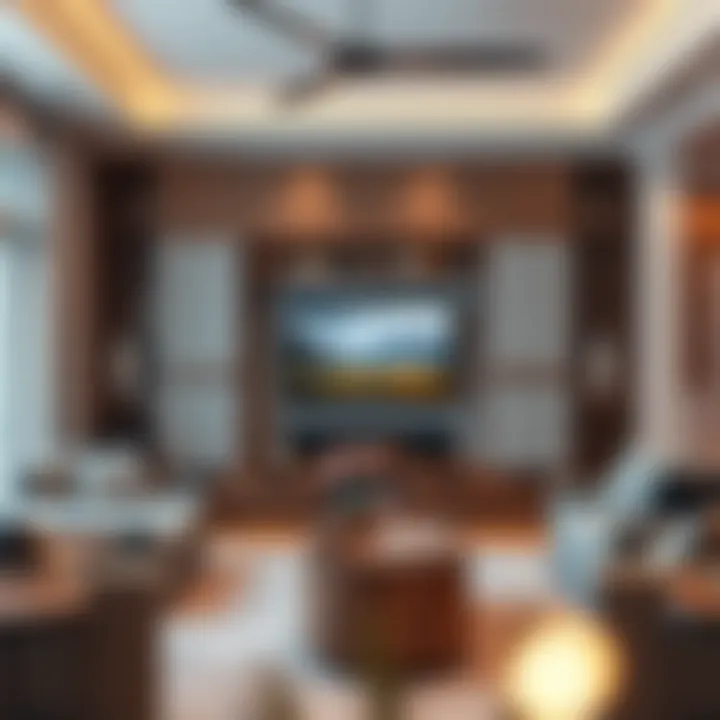
Incorporating these design aspects into your selection process means you will not only choose a stunning piece of furniture but also one that elevates your overall viewing ritual. Remember, a well-integrated, ergonomic entertainment center doesn’t just serve your media needs; it also enhances your space in ways that blend style, function, and comfort seamlessly.
"Choosing the right entertainment center is more than aesthetics; it’s about creating an environment that enhances your lifestyle and viewing comfort."
By carefully evaluating functionality and usability, you’ll ensure that your entertainment center meets the demands of your household while looking sharp doing it. Ultimately, the right choice can significantly impact your home entertainment experience, turning a simple area into a focal point of enjoyment.
Choosing the Right Location
Selecting the appropriate spot for a 70-inch entertainment center can make or break your overall viewing experience. It's not just about where the unit looks nice; it fundamentally influences usability, aesthetics, and even the comfort of your family gatherings. Given the significant size of a 70-inch entertainment center, understanding how its placement affects the visual and functional dynamics of a room is crucial.
Assessing Room Dimensions and Layout
Before you even think about where to place your entertainment center, the first step is measuring your room. Knowing the dimensions can feel like looking into a crystal ball. You hope to see what fits, how it flows, and what it contributes to the room's overall vibe.
- Measure Twice, Place Once: Grab a tape measure and jot down the length, width, and height of the room. Ensure to gauge the placement of doors, windows, and any built-in fixtures that can either obstruct or enhance the space.
- Visualize the Layout: Take a moment to pause and envision how your entertainment center will interface with your seating arrangements. Ideally, you want your couch or chairs positioned for comfort and visibility when watching TV. If the viewing angle is awkward, you might lose more than just the enjoyment of a good movie; it could also frustrate family game nights.
- Consider Flow of Movement: It’s vital the arrangement allows smooth traffic flow through the room. A well-placed entertainment center should not block pathways, allowing for easy access to all areas.
Creating a Focal Point in the Space
After you've assessed the room layout, it’s time to turn your attention to focal points. The right location for your entertainment center can create a stunning centerpiece that draws the eye and sets the atmosphere for the entire room.
- Align with the Architecture: If your room has architectural features such as a fireplace or artwork, consider positioning your entertainment center to complement those elements. This synergy can create a harmonious environment that feels carefully designed rather than haphazard.
- Balance and Symmetry: A 70-inch entertainment center commands presence. Placing it centrally can lend balance to the overall layout. Using flanking decor, like bookshelves or decorative plants on either side, can enhance this illusion of symmetry, adding sophistication.
"The location of your entertainment center not only determines the functionality but also enhances the aesthetic appeal of your space. Choosing wisely can elevate the entire ambiance."
- Lighting Considerations: Don’t forget about lighting! The entertainment center should ideally be in a location where it won’t be affected by glare from windows or light fixtures. Adding mood lighting around can also create an inviting atmosphere for movie nights.
By mindfully assessing the room dimensions and layout, and by strategically creating a focal point, you are not just choosing a spot for an entertainment center; you are thoughtfully enhancing the entire living space. With intention and careful planning, your new entertainment center can become an integral part of your home, perfectly framing your entertainment experience.
Color Schemes and Decor Integration
Choosing an entertainment center is not just about functionality; it’s also about how well it fits into your overall home aesthetic. The right color scheme plays a pivotal role in this integration. A thoughtfully selected palette can transform a living space, making a 70-inch entertainment center not merely a piece of furniture but a statement within the room. Failing to consider color and decor can lead to a disjointed look, turning what could be a harmonious space into a visual disarray.
Color Psychology in Entertainment Spaces
Colors do more than beautify; they influence moods and behaviors. For instance, blue tones often evoke feelings of calm and relaxation. This could be ideal for a movie-watching environment where you want to unwind. On the flip side, a vibrant red might stir energy and excitement, perhaps more suited for a game room where high spirits are essential.
It's crucial to understand how potential colors connect with activities in your entertainment space. Here are some common color associations to ponder:
- Blue: Calming and soothing, great for family movie nights.
- Green: Refreshing and natural, perfect for casual gatherings.
- Red: Invigorating; may not be the best for relaxation but fits well in vibrant activity zones.
- Neutral tones: Adaptable and timeless, allowing for a flexible backdrop.
When selecting a color scheme for your entertainment center, consider how these colors will blend with your room's current hues. This ensures that your entertainment center complements rather than clashes, paving the way for a cohesive look.
Complementing Existing Decor with Color Choices
To make your entertainment center a seamless part of your decor, it’s essential to take stock of existing colors and styles in your living space. Here are some actionable steps to guide you:
- Inventory Your Current Colors: Take a good look around. Which colors dominate your space? Are they warm earth tones, cool blues, or perhaps monochromatic shades?
- Match or Contrast: Decide whether you want your entertainment center to blend in or stand out. Matching can create a serene ambiance, while contrasting colors might draw the eye and foster creativity.
- Consider Materials: Different materials reflect colors differently. For instance, a glossy finish can brighten a hue, while a matte surface might mute it. Keep the material of your entertainment center in mind as you choose your shades.
- Get Samples: Before making a commitment, acquire color samples. Many home improvement stores offer small portions you can take home. This allows you to see how a color plays with your lighting at different times of the day.
In summary, a well-thought-out color scheme doesn't just enhance the aesthetic value of your entertainment area; it can elevate the overall atmosphere of your home. Combine color psychology with an understanding of your existing decor to create a space that feels both inviting and stylish. Remember, your entertainment center is more than just a functional item; it’s an opportunity to express your taste and style.
Budgeting for a 70-Inch Entertainment Center
Establishing a budget for your 70-inch entertainment center is akin to laying the first brick in the house of your home theater dreams. It's essential to clearly outline what you're willing to invest, as this can determine not only the design and materials of your entertainment center but also the overall quality and functionality.
With so much to choose from, understanding your budget sets the stage for the entire selection process. When exploring this segment of home design, I’ve found that many overlook the significance of not just the initial cost but also the potential long-term investments associated with their choice. After all, a beautiful entertainment center isn't worthwhile if it falls apart after a few seasons of binge-watching.
Understanding Price Ranges and Quality
Price ranges for entertainment centers can vary tremendously, influenced by factors such as materials, brand reputation, and craftsmanship. You can find a simple unit for as little as $200, while premium options can soar above $2000. So, what gives?
When sifting through options, consider the following:
- Materials: Solid wood frames generally offer durability compared to those made with particleboard or MDF. Investing in solid wood is not just about appearance; it can impact longevity.
- Brand Reputation: Well-established brands often provide warranties and customer support that knock the competition out of the park.
- Features: Built-in technology or clever storage solutions might raise the price but can also enhance usability, making it worth every penny.
In the end, aligning your desired features with your budget helps ensure you don’t overextend yourself financially while still finding something visually appealing and practical.
Evaluating Long-Term Value versus Initial Cost
Every dollar spent on your entertainment center should think about the bigger picture. The initial cost is merely one piece of the puzzle; long-term value is where the real smart spending lies. A cheap entertainment center might seem attractive now, but consider this:

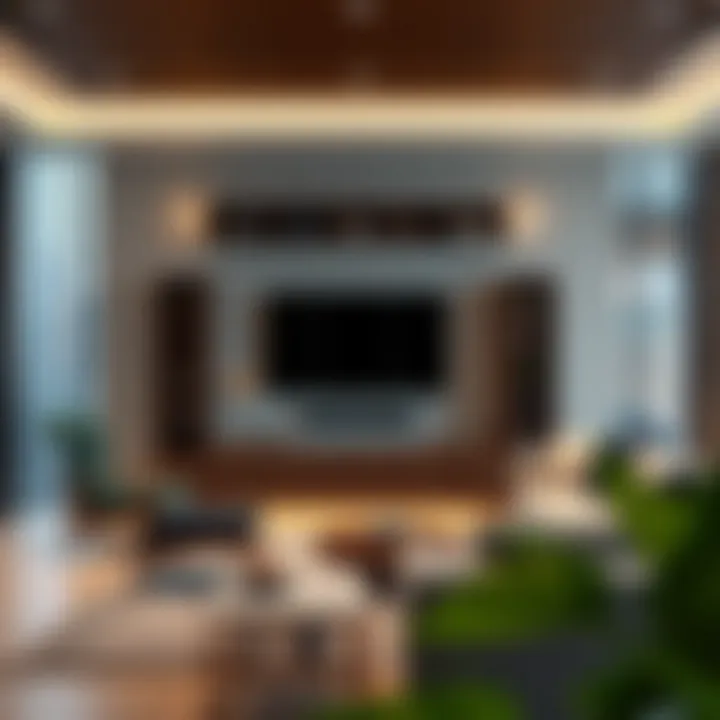
- Durability: Will it survive the test of time, or will you find yourself replacing it in a few years?
- Maintenance: How easy it to keep clean, or does it require special care? Some materials demand a bit more TLC, which might not be economical in the long run.
- Aesthetic Changes: If you plan to redecorate down the line, a timeless design might save you the trouble of buying another unit sooner than expected.
Wear and tear becomes a reality, and what seems a bargain today can turn into an expense tomorrow.
By viewing budgeting through a lens that encompasses both accessibly priced options and those that promise long-lasting quality, you can confidently choose a 70-inch entertainment center that will keep you satisfied and perhaps save you some cash in the long haul. Balancing how much you spend now with what you gain in the future will allow you to create a space that feels harmonious while being practical.
Maintenance and Care
When you invest in a 70-inch entertainment center, it's akin to bringing home a new family member. These substantial pieces often act as the central hub for all entertainment activities, so their upkeep is critical. Understanding the importance of maintenance not only prolongs the life of your furniture but also keeps your living space looking fresh and inviting. A few minutes spent on care can save hours of frustration later. Here’s why maintenance should be on your radar.
Regular cleaning and slight repairs help preserve both aesthetics and functionality. Most importantly, each material used in crafting entertainment centers has its requirements for cleaning and upkeep. Neglecting these elements can lead to damaged finishes or decreased structural integrity, which, in turn, can affect your television or other cherished electronic devices.
"An ounce of prevention is worth a pound of cure." This old saying holds true in the context of maintaining household furniture.
Cleaning Recommendations for Different Materials
The materials that make up your entertainment center play a significant role in how to clean them and maintain their longevity. Here are tailored tips for common materials:
- Wood: Opt for a soft, lint-free cloth for regular dusting. If more cleaning is needed, a mild soap mixed with water can help. Ensure to dry off any excess moisture with another cloth. Avoid abrasive cleaners that can scratch the surface.
- Glass: For glass fronts or accents, a glass cleaner can work wonders. Use a microfibre cloth to avoid streaking. It's best to clean glass when the sun isn't shining directly on it, which can dry the cleaner too quickly.
- Metal: Stainless steel or metal components can be cleaned with dedicated metal polish. A damp cloth works for wiping dust, but steer clear of harsh cleaners that can cause corrosion.
- Fabric: If your entertainment center has fabric elements, such as shelves or backs, vacuum them with a brush attachment. Spot clean with a fabric cleaner when needed but test any cleaning solution on a small area first.
Dealing with Wear and Tear Over Time
Regardless of how careful you are, wear and tear is often inevitable as time passes. Keeping a keen eye on these details can help you manage issues before they escalate:
- Scratches: For wooden surfaces, there are furniture repair markers or wood fillers available in various shades. These can help disguise small scratches.
- Dings and Dents: Utilize a damp cloth and an iron to treat dings in wood. Place the damp cloth over the area, then gently apply heat with the iron for a few seconds. This can help raise the wood fibers back into place.
- Loose Joints: Regularly check the joints and screws of your unit. Tightening them at intervals can help prevent furniture wobble and ensure everything remains secure.
Staying proactive with your maintenance routine is crucial. A little effort goes a long way and ensures your entertainment center remains a centerpiece of enjoyment for years to come.
Future Trends in Entertainment Center Design
In an ever-evolving market where home entertainment has taken center stage, recognizing the future trends in entertainment center design is crucial for homeowners and decorators alike. As technology advances and personal preferences shift, the standards for entertainment centers are also being rewritten. From customization to sustainability, understanding these trends can help in making informed decisions that not only enhance the aesthetics of a space but also meet functional needs.
The significance of these trends lies in their ability to respond to the diverse demands of modern living. People look for flexibility in design, merging utility with style. This article section sheds light on what’s on the horizon and why it matters for potential buyers.
Increasing Demand for Customization
Customization has become a game changer in the world of entertainment center design. Homeowners no longer want a one-size-fits-all solution. Instead, they seek furniture that reflects their unique identities and caters to their specific requirements. This shift has led to a rise in modular designs; systems that can be modified to suit different spaces or functions.
Some of the reasons behind the growing demand for customization include:
- Versatility: With modular systems, it is easy to rearrange sections as needs change over time. Whether you want to shift things around for a movie night or switch the arrangement for a gathering, customized furniture fits the bill.
- Personal Expression: Customized entertainment centers allow individuals to express their tastes in colors, materials, and styles, creating a truly personal sanctuary.
- Space Efficiency: Tailored designs can maximize the use of available space. Rather than struggling to fit a large unit into a room, homeowners can opt for built-ins or smaller modular pieces that utilize every nook efficiently.
Ultimately, the personalization trend is all about creating a seamless blend between functionality and individual style, making spaces feel more inviting and practical.
Sustainability and Eco-Friendly Materials
As awareness of environmental issues grows, so does the inclination toward sustainability in design. Homeowners are increasingly concerned with the environmental impact of their furniture options, making eco-friendly materials a priority in future entertainment center designs.
Using sustainable materials not only helps in preserving natural resources but also appeals to eco-conscious buyers. Here are some materials and practices that are gaining traction:
- Reclaimed Wood: With its unique character and history, reclaimed wood has gained popularity. It reduces waste and gives a rustic feel to modern setups.
- Bamboo: Fast-growing and highly renewable, bamboo is a prime alternative to hardwood. It is both durable and stylish, perfect for contemporary designs.
- Low VOC Finishes: Many manufacturers are moving towards non-toxic paints and finishes to ensure healthier indoor air quality. This is an important consideration for families, especially with young children.
Incorporating sustainability into the design doesn't just benefit the environment; it also resonates with consumers who value ethical choices in their purchasing habits. When your entertainment unit is both stylish and eco-friendly, it’s a win-win.
Going green isn’t just a passing trend; it’s becoming a fundamental principle that shapes future designs.
Finale
Choosing the right 70-inch entertainment center requires significant thought and consideration. In this article, various aspects were explored, particularly focusing on the importance of blending functionality with aesthetic appeal. One cannot overemphasize how a well-chosen entertainment center contributes not just to the visual design of a living space, but also to the overall experience of home entertainment.
Summarizing Key Considerations
When selecting an entertainment center, several factors deserve your attention:
- Size and Space: Understand the dimensions of your room and how the entertainment center interacts with other furniture. A piece that fits well will not only elevate your décor but also ensure comfort.
- Material Quality: The choice of materials can impact durability and aesthetics. Hardwoods might offer timeless elegance, while modern materials can add a sleek appeal, depending on your style.
- Storage Needs: Think about your media collection and related accessories. Ample storage space can make a huge difference in keeping the area tidy and organized.
- Design Compatibility: The entertainment center should harmonize with your existing décor. This may involve color choices, styles, or overall design elements that echo throughout your home.
- Budget Awareness: Quality often correlates with price, but it’s essential to strike a balance between what you want and what you can afford. Consider long-term investment value when making your choice.
“A thoughtful selection leads not only to satisfaction but also reflects personal style and living priorities.”
Encouraging Thoughtful Selection
Engaging in a thoughtful selection process can transform not just the way your space looks, but also how you interact with it daily. It’s vital to approach your choices with the mindset that this is a long-term investment. Picture where you want to be in five years - will that entertainment center still serve your needs?
Keep in mind that trends come and go, but a well-considered piece can stand the test of time. Embrace what truly resonates with you and your lifestyle, and don’t rush into a decision because of fleeting trends or peer pressure. Educate yourself, consult various resources like Britannica for design insights, or join discussions on relevant forums like Reddit to gather diverse perspectives. With patience and careful planning, you’ll create a space that is not merely functional but also reflects your distinct personality and style.
By being mindful of these factors and insights, you can navigate your choices with confidence, ensuring that your 70-inch entertainment center will be a source of enjoyment for years to come.







